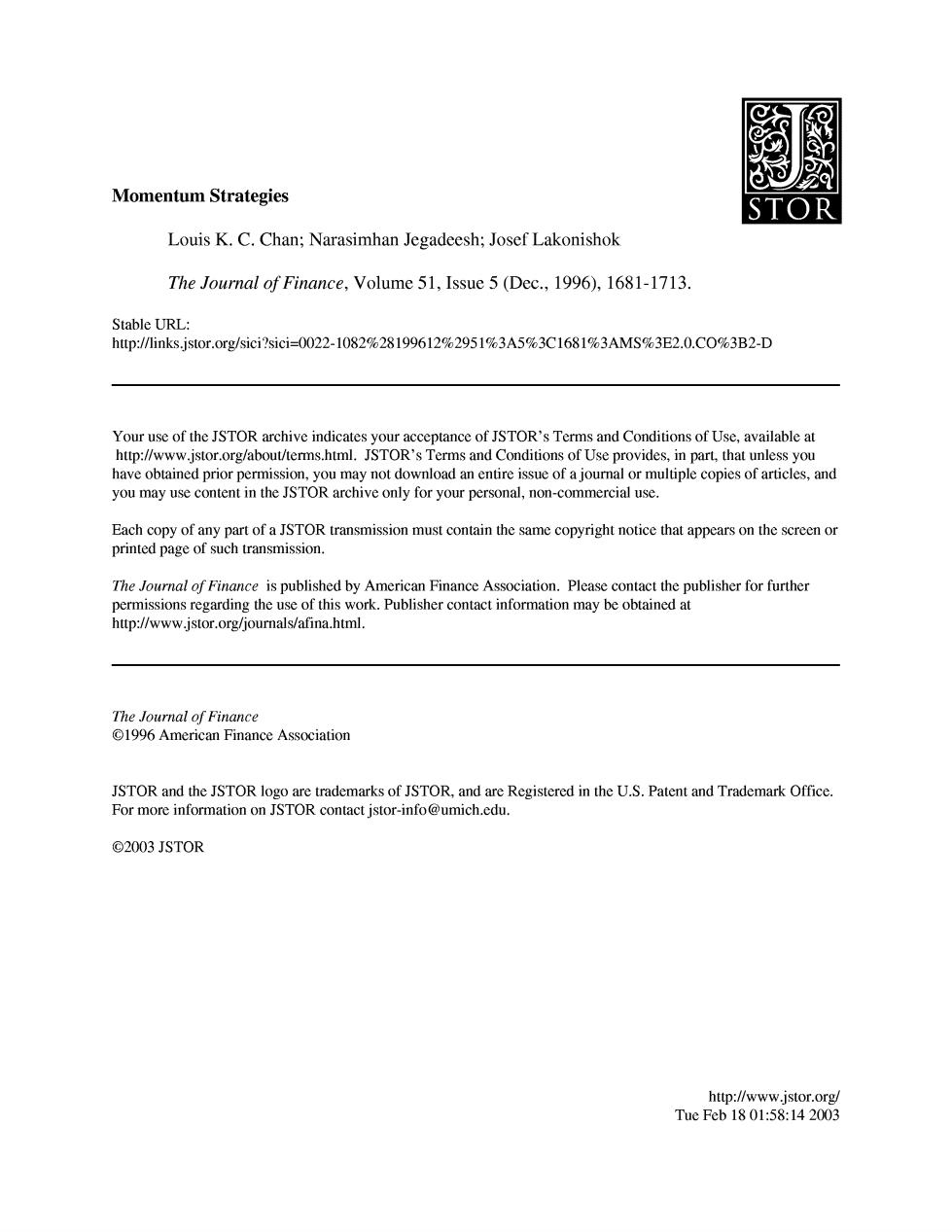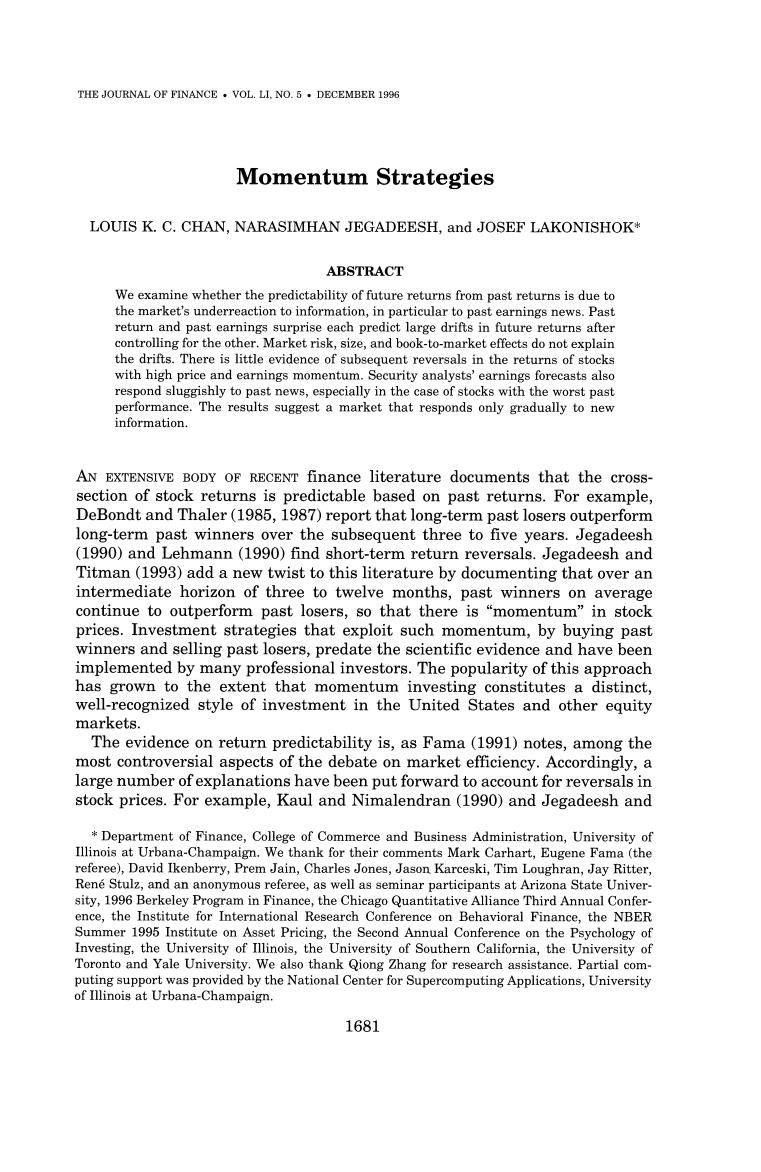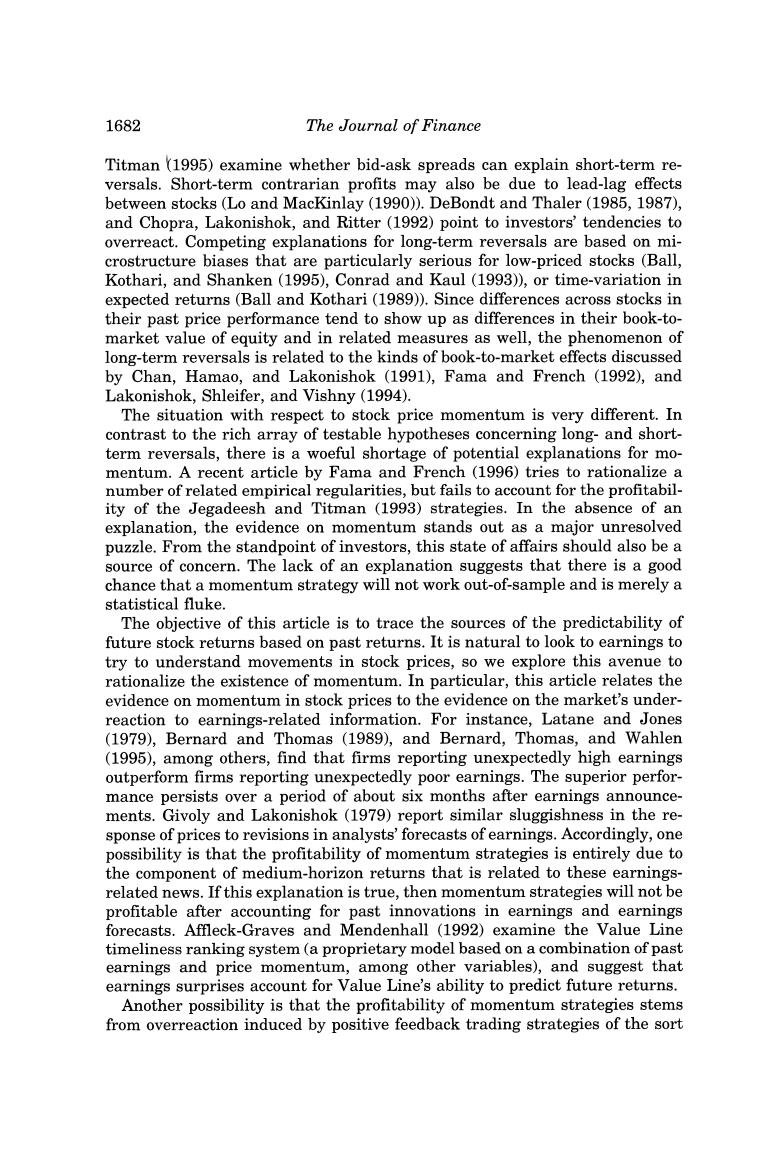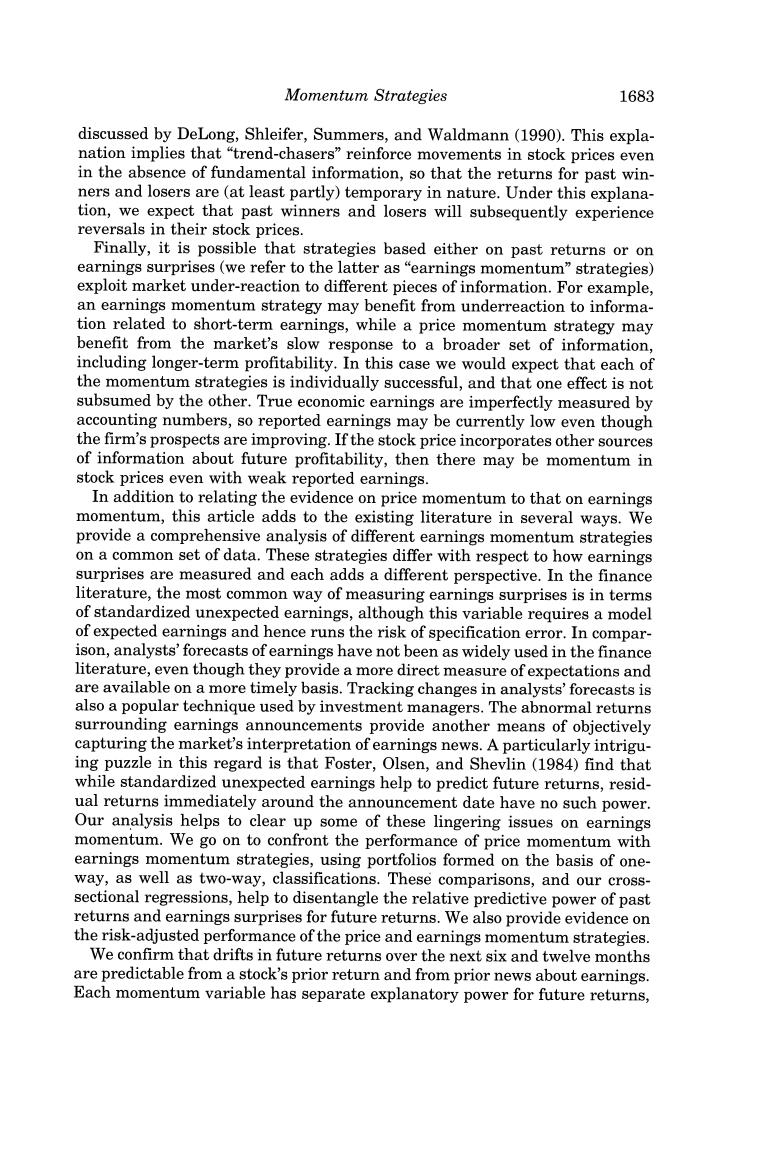
Momentum Strategies STOR Louis K.C.Chan;Narasimhan Jegadeesh;Josef Lakonishok The Journal of Finance,Volume 51,Issue 5(Dec.,1996),1681-1713 Stable URL: http:/links.istor.org/sici2sici=0022-1082%28199612%2951%3A5%3C1681%3AMS%3E2.0.C0%3B2-D Your use of the JSTOR archive indicates your acceptance of JSTOR's Terms and Conditions of Use,available at http://www.jstor.org/about/terms.html.JSTOR's Terms and Conditions of Use provides,in part,that unless you have obtained prior permission,you may not download an entire issue of a journal or multiple copies of articles,and you may use content in the JSTOR archive only for your personal,non-commercial use. Each copy of any part of a JSTOR transmission must contain the same copyright notice that appears on the screen or printed page of such transmission. The Journal of Finance is published by American Finance Association.Please contact the publisher for further permissions regarding the use of this work.Publisher contact information may be obtained at http://www.jstor.org/journals/afina.html. The Journal of Finance 1996 American Finance Association JSTOR and the JSTOR logo are trademarks of JSTOR,and are Registered in the U.S.Patent and Trademark Office. For more information on JSTOR contact jstor-info@umich.edu. ©2003 JSTOR http://www.jstor.org/ Tue Feb1801:58:142003

THE JOURNAL OF FINANCE.VOL.LI.NO.5.DECEMBER 1996 Momentum Strategies LOUIS K.C.CHAN,NARASIMHAN JEGADEESH,and JOSEF LAKONISHOK* ABSTRACT We examine whether the predictability of future returns from past returns is due to the market's underreaction to information,in particular to past earnings news.Past return and past earnings surprise each predict large drifts in future returns after controlling for the other.Market risk,size,and book-to-market effects do not explain the drifts.There is little evidence of subsequent reversals in the returns of stocks with high price and earnings momentum.Security analysts'earnings forecasts also respond sluggishly to past news,especially in the case of stocks with the worst past performance.The results suggest a market that responds only gradually to new information. AN EXTENSIVE BODY OF RECENT finance literature documents that the cross- section of stock returns is predictable based on past returns.For example, DeBondt and Thaler(1985,1987)report that long-term past losers outperform long-term past winners over the subsequent three to five years.Jegadeesh (1990)and Lehmann (1990)find short-term return reversals.Jegadeesh and Titman(1993)add a new twist to this literature by documenting that over an intermediate horizon of three to twelve months,past winners on average continue to outperform past losers,so that there is "momentum"in stock prices.Investment strategies that exploit such momentum,by buying past winners and selling past losers,predate the scientific evidence and have been implemented by many professional investors.The popularity of this approach has grown to the extent that momentum investing constitutes a distinct, well-recognized style of investment in the United States and other equity markets. The evidence on return predictability is,as Fama(1991)notes,among the most controversial aspects of the debate on market efficiency.Accordingly,a large number of explanations have been put forward to account for reversals in stock prices.For example,Kaul and Nimalendran (1990)and Jegadeesh and Department of Finance,College of Commerce and Business Administration,University of Illinois at Urbana-Champaign.We thank for their comments Mark Carhart,Eugene Fama(the referee),David Ikenberry,Prem Jain,Charles Jones,Jason Karceski,Tim Loughran,Jay Ritter, Rene Stulz,and an anonymous referee,as well as seminar participants at Arizona State Univer- sity,1996 Berkeley Program in Finance,the Chicago Quantitative Alliance Third Annual Confer- ence,the Institute for International Research Conference on Behavioral Finance,the NBER Summer 1995 Institute on Asset Pricing,the Second Annual Conference on the Psychology of Investing,the University of Illinois,the University of Southern California,the University of Toronto and Yale University.We also thank Qiong Zhang for research assistance.Partial com- puting support was provided by the National Center for Supercomputing Applications,University of Illinois at Urbana-Champaign. 1681

1682 The Journal of Finance Titman(1995)examine whether bid-ask spreads can explain short-term re- versals.Short-term contrarian profits may also be due to lead-lag effects between stocks(Lo and MacKinlay (1990)).DeBondt and Thaler(1985,1987), and Chopra,Lakonishok,and Ritter(1992)point to investors'tendencies to overreact.Competing explanations for long-term reversals are based on mi- crostructure biases that are particularly serious for low-priced stocks (Ball, Kothari,and Shanken (1995),Conrad and Kaul(1993)),or time-variation in expected returns(Ball and Kothari (1989)).Since differences across stocks in their past price performance tend to show up as differences in their book-to- market value of equity and in related measures as well,the phenomenon of long-term reversals is related to the kinds of book-to-market effects discussed by Chan,Hamao,and Lakonishok (1991),Fama and French (1992),and Lakonishok,Shleifer,and Vishny (1994). The situation with respect to stock price momentum is very different.In contrast to the rich array of testable hypotheses concerning long-and short- term reversals,there is a woeful shortage of potential explanations for mo- mentum.A recent article by Fama and French (1996)tries to rationalize a number of related empirical regularities,but fails to account for the profitabil- ity of the Jegadeesh and Titman (1993)strategies.In the absence of an explanation,the evidence on momentum stands out as a major unresolved puzzle.From the standpoint of investors,this state of affairs should also be a source of concern.The lack of an explanation suggests that there is a good chance that a momentum strategy will not work out-of-sample and is merely a statistical fluke. The objective of this article is to trace the sources of the predictability of future stock returns based on past returns.It is natural to look to earnings to try to understand movements in stock prices,so we explore this avenue to rationalize the existence of momentum.In particular,this article relates the evidence on momentum in stock prices to the evidence on the market's under- reaction to earnings-related information.For instance,Latane and Jones (1979),Bernard and Thomas (1989),and Bernard,Thomas,and Wahlen (1995),among others,find that firms reporting unexpectedly high earnings outperform firms reporting unexpectedly poor earnings.The superior perfor- mance persists over a period of about six months after earnings announce- ments.Givoly and Lakonishok(1979)report similar sluggishness in the re- sponse of prices to revisions in analysts'forecasts of earnings.Accordingly,one possibility is that the profitability of momentum strategies is entirely due to the component of medium-horizon returns that is related to these earnings- related news.If this explanation is true,then momentum strategies will not be profitable after accounting for past innovations in earnings and earnings forecasts.Affleck-Graves and Mendenhall (1992)examine the Value Line timeliness ranking system(a proprietary model based on a combination of past earnings and price momentum,among other variables),and suggest that earnings surprises account for Value Line's ability to predict future returns. Another possibility is that the profitability of momentum strategies stems from overreaction induced by positive feedback trading strategies of the sort

Momentum Strategies 1683 discussed by DeLong,Shleifer,Summers,and Waldmann(1990).This expla- nation implies that "trend-chasers"reinforce movements in stock prices even in the absence of fundamental information,so that the returns for past win- ners and losers are (at least partly)temporary in nature.Under this explana- tion,we expect that past winners and losers will subsequently experience reversals in their stock prices. Finally,it is possible that strategies based either on past returns or on earnings surprises(we refer to the latter as "earnings momentum"strategies) exploit market under-reaction to different pieces of information.For example, an earnings momentum strategy may benefit from underreaction to informa- tion related to short-term earnings,while a price momentum strategy may benefit from the market's slow response to a broader set of information, including longer-term profitability.In this case we would expect that each of the momentum strategies is individually successful,and that one effect is not subsumed by the other.True economic earnings are imperfectly measured by accounting numbers,so reported earnings may be currently low even though the firm's prospects are improving.If the stock price incorporates other sources of information about future profitability,then there may be momentum in stock prices even with weak reported earnings. In addition to relating the evidence on price momentum to that on earnings momentum,this article adds to the existing literature in several ways.We provide a comprehensive analysis of different earnings momentum strategies on a common set of data.These strategies differ with respect to how earnings surprises are measured and each adds a different perspective.In the finance literature,the most common way of measuring earnings surprises is in terms of standardized unexpected earnings,although this variable requires a model of expected earnings and hence runs the risk of specification error.In compar- ison,analysts'forecasts of earnings have not been as widely used in the finance literature,even though they provide a more direct measure of expectations and are available on a more timely basis.Tracking changes in analysts'forecasts is also a popular technique used by investment managers.The abnormal returns surrounding earnings announcements provide another means of objectively capturing the market's interpretation of earnings news.A particularly intrigu- ing puzzle in this regard is that Foster,Olsen,and Shevlin (1984)find that while standardized unexpected earnings help to predict future returns,resid- ual returns immediately around the announcement date have no such power. Our analysis helps to clear up some of these lingering issues on earnings momentum.We go on to confront the performance of price momentum with earnings momentum strategies,using portfolios formed on the basis of one- way,as well as two-way,classifications.These comparisons,and our cross- sectional regressions,help to disentangle the relative predictive power of past returns and earnings surprises for future returns.We also provide evidence on the risk-adjusted performance of the price and earnings momentum strategies. We confirm that drifts in future returns over the next six and twelve months are predictable from a stock's prior return and from prior news about earnings. Each momentum variable has separate explanatory power for future returns

1684 The Journal of Finance so one strategy does not subsume the other.There is little sign of subsequent reversals in returns,suggesting that positive feedback trading cannot account for the profitability of momentum strategies.If anything,the returns for companies that are ranked lowest by past earnings surprise are persistently below average in the following two to three years.Security analysts'forecasts of earnings are also slow to incorporate past earnings news,especially for firms with the worst past earnings performance.The bulk of the evidence thus points to a delayed reaction of stock prices to the information in past returns and in past earnings. The remainder of the article is organized as follows.Section I describes the sample and our methodology.Univariate analyses of our different momentum strategies are carried out in Section II,while the results from multivariate analyses are reported in Section III.Section IV examines whether price and earnings momentum are subsequently corrected.Section V checks that our results are robust by replicating the results for larger companies only,and by controlling for risk factors.Section VI concludes. I.Sample and Methodology We consider all domestic,primary stocks listed on the New York (NYSE), American (AMEX),and Nasdag stock markets.Closed-end funds,Real Estate Investment Trusts(REITs),trusts,American Depository Receipts(ADRs),and foreign stocks are excluded from the analysis.Since we require information on earnings,the sample comprises all companies with coverage on both the Center for Research in Security Prices(CRSP)and COMPUSTAT(Active and Research)files.The data for firms in this sample are supplemented,wherever available,with data on analysts'forecasts of earnings from the Lynch,Jones, and Ryan Institutional Brokers Estimate System (I/B/E/S)database. At the beginning of every month from January 1977 to January 1993,we rank stocks on the basis of either past returns or a measure of earnings news. To be eligible,a stock need only have data available on the variable(s)used for ranking,even though we provide information on other stock attributes.The ranked stocks are then assigned to one of ten decile portfolios,where the breakpoints are based only on NYSE stocks.In our earnings momentum strategies,the breakpoints in any given month are based on all NYSE firms that have reported earnings within the prior three months.This takes into account a complete cycle of earnings announcements.All stocks are equally- weighted within a given portfolio. The ranking variable used in our price momentum strategy is a stock's past compound return,extending back six months prior to portfolio formation.In our earnings momentum strategies,we use three different measures of earn- ings news.Our first is the commonly used standardized unexpected earnings (SUE)variable.Foster,Olsen,and Shevlin (1984)examine different time series models for expected earnings and how the resulting measures of unan- ticipated earnings are associated with future returns.They find that a sea- sonal random walk model performs as well as more complex models,so we use